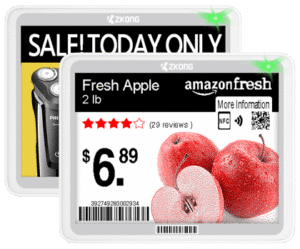Electronic Shelf Labeling: Revolutionizing Retail for Efficiency and Customer Experience

In the fast-paced world of retail, staying ahead of the competition and meeting the ever-evolving needs of customers is paramount. One technology that has been making waves in the industry is Electronic Shelf Labeling (ESL). These digital price tags have transformed the way retailers manage and display product information, revolutionizing the shopping experience for both customers and store owners alike.
Traditional paper-based price tags have been a staple in retail for decades, but they come with inherent challenges. Updating prices and product information on thousands of shelves is a labor-intensive and time-consuming process, leaving room for errors and inconsistencies. This inefficiency often leads to pricing discrepancies between the point-of-sale system and the shelf, frustrating customers and causing revenue loss for retailers.
Enter Electronic Shelf Labeling, a game-changer in the retail landscape. ESL systems consist of small, battery-powered digital displays that attach to store shelves. These labels are wirelessly connected to a central management system that allows retailers to update prices, product details, promotions, and other information in real-time. The ESLs can display product names, prices, barcodes, and even dynamic information like stock levels, reviews, and nutritional facts.
One of the primary benefits of ESL is the significant reduction in operational costs and
human errors. Retailers can instantly update prices across all stores, eliminating the need for manual price changes. This ensures consistency between the shelf and the checkout, preventing customer frustration and cashier interventions. The automated process also frees up staff to focus on more strategic tasks, enhancing overall store efficiency.
Additionally, ESL enables retailers to implement dynamic pricing strategies easily. Prices can be adjusted instantly in response to market conditions, competitor pricing, or demand fluctuations. This flexibility allows retailers to optimize pricing to increase sales and maximize profits while maintaining competitiveness.
Moreover, ESL systems enhance the customer experience by providing valuable information at the point of purchase. Shoppers can quickly access detailed product descriptions, user reviews, and complementary product suggestions, empowering them to make more informed buying decisions. For instance, ESL can display allergen information for food products, helping customers with dietary restrictions easily identify suitable options.
Retailers can also leverage ESL to run targeted promotions and personalized offers. Special discounts and limited-time offers can be displayed on the digital labels, attracting attention and driving impulse purchases. The ability to tailor promotions based on customer preferences and buying history can boost customer loyalty and satisfaction.
Beyond price management and promotions, ESL opens the door to data-driven insights. Retailers can track customer interactions with product displays and monitor how pricing changes impact sales in real-time. This valuable data enables better inventory management, product placement optimization, and overall store performance analysis.
The adoption of ESL has been gaining momentum across various retail sectors, including grocery stores, electronics retailers, fashion outlets, and DIY chains. Large retail chains have been early adopters of the technology due to their extensive product offerings and complex pricing structures. However, smaller retailers are also recognizing the advantages of ESL and are starting to implement these systems to improve their competitiveness.
Despite the many benefits, the widespread adoption of ESL has faced some challenges. Initial implementation costs, including the price of the labels and the required infrastructure, can be substantial. Additionally, retailers need to invest in staff training to ensure the efficient use of the ESL system. However, the long-term savings in labor costs and improved customer satisfaction often outweigh these upfront expenses.
In conclusion, Electronic Shelf Labels is transforming the retail industry by streamlining price management, enhancing customer experience, and enabling data-driven decision-making. As technology continues to evolve, we can expect even more innovative features and applications to further revolutionize the retail landscape. Retailers that embrace ESL will be better equipped to meet the demands of modern consumers and gain a competitive edge in the ever-changing retail market.
- SHARES

Ashmawi Sami has a Bachelor degree in Travel and Tourism Management from the University of Minnesota. He has his own travel vlogging channel. Besides being a fantastic yoga instructor he has travelled to 9 countries and planning his next trip soon. As the father of 3 dogs, he is well-trained in parenting, crowd control, and crisis situations.
ABOUT ME

Gillian is a freelance blogger, student, and full-time traveler. Each day she spends her time exploring something exciting to help people find the information they need while travelling to a new destination. Whether it be the place to enjoy holidays, or a spot to throw a party or hidden gems that you must visit in the city.
ALL CATEGORIES
- Adventure (13)
- Automotive (8)
- Business (670)
- Education (13)
- Event (4)
- Health (285)
- Indibet App 740 (1)
- Insurance (11)
- Lifestyle (12)
- News (1)
- Real Estate (19)
- Shopping (26)
- Technology (22)
- Travel (6)

JOIN US TODAY
POPULAR POST
January 27, 2021 -
Adventure Travel For The Audacious Spirit
January 27, 2021 -
Small Business Loans for Women
January 27, 2021 -
Adventure Tours in Vanuatu
RECENT POST
April 24, 2025 -
The Most Effective Bitcoin Gambling Establishments: A Comprehensive Overview
Bitcoin, the globe's first decentralized electronic money, has...
April 23, 2025 -
The various types of Online Casino Bonuses
Casino online, also known casino mit entercash as...
April 23, 2025 -
Gambling Enterprise Online Genuine Cash: A Comprehensive Overview
Invite to our insightful article concerning online casino...







